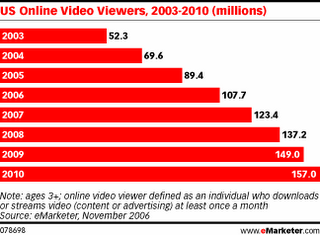
Netflix is working with LG Electronics to market a set-top-box=based movie download service for TVs, Business Week reports. The move is not unexpected, but is significant in terms of its timing. Netflix has over the last few years modified its statements about the DVD rental business, moving from a "consumers don't want to mess with downloading" to "we'll do it when it's the right time" stance.
The move now means it is "time." The transition from physical distribution of movie content to electronic download to TVs is underway, Netflix is signaling. The service, which extends the Netflix download service beyond "movies to your PC," is expected to begin service in the fall of 2008.
And though Apple TV has not gotten much traction, Business Week expects Apple to unveil its own download-to-TV service as well.
Netflix has been offerings downloads to PCs for about a year. But just about everybody who thinks about the matter agrees that downloads directly to TV screens is what is needed to really jumpstart the business.
Amazon.com, TiVo and Blockbuster also have decided they no longer can wait to enter the nascent business.
Again, what is important about the Netflix move is the timing, not the move itself. Netflix has concluded that even if revenues from online-to-TV downloading will not eclipse DVD rentals for some time, one tipping point has been reached. Netflix has to get into position now if it wants to maintain leadership in the movie rental business of the future.
By some reckoning, that business already is entering its 3.0 phase, having started with retail store rentals, followed by mail delivery and now starting the download phase.
And it is worth noting that if cable TV "pay per view" or "on demand" efforts had been quite a bit more than a niche, the video rental business and Netflix would not have developed. Cablers will note that studio licensing rules and release windows account for the rise of the independent video and DVD rental business.
That is true. What also is true is that studio profit margins and gross revenues control the availability of product. Once studios decide they can make as much, or more money, by switching to online distribution, they will do it.
In that regard, a recent slowdown in growth rates for DVD sales in retail outlets is another important market indicator. Consumer fascination with DVD purchases might be waning, overall. Legally or illegally, online-delivered content might be a contributing factor.
So legal alternatives such as Netflix will provide should have a shot at success. What remains to be seen is how widespread adoption will be. Consumers are quite fickle about special-purpose electronics devices. If the value is high enough Netflix will not find there is a problem. "No late fees" and "no drive to the store" have proven to have high consumer value.
But Netflix also seems to be pursuing the integration of the decoder circuits into other Internet-connected devices. The decoding software might reside into a TV, a game player or media reader, for example. That would alleviate the "one more box" barrier, as some consumers just don't want another device, with cords and cables, around their entertainment center.
On the other hand, Netflix then encounters the "only available on one model or one brand" problem. Consumers generally don't want to bother with "this flavor of access on this device" issue.
And though on-demand video should in principle provide even more convenience, the problem has been the content release windows, which essentially dictate that by the time an on-demand movie is available, consumers have had lots of other opportunities to view the content.
For the moment, at least, Netflix should continue to have an advantage over cable, satellite or telco on-demand content. The studios aren't going to disrupt the profitable DVD window just because online delivery now is possible.
Providers of broadband access services face a more complex business challenge. Demand for download speeds should get a boost if the download services take off. The issue is how much actual profit might exist. The problem with video is that it offers scant returns on a cents-per-bit basis compared to voice.
Put another way, video necessarily "commoditizes bandwidth." For those of you who are Bellheads, think of it this way. A two-hour movie delivered in widescreen format essentially requires bandqwidth equivalent to a DS-3 with a holding time of two hours(45 Mbps). True, we compress and pre-process now so only 4 Mbps to 6 Mbps is needed.
But the point is that the value of a 4 Mbps to 6 Mbps circuit used continuously for two hours or so is "worth" what a consumer deems a fair price for watching a two-hour video event. Call it $3 to $7, depending on what the content is and when it can be viewed.
All bits are not valued equally. On a cents-per-bit basis, text messages represent the highest return, with voice someplace in the middle and video at the very low end of the revenue continuum.
It might not matter so much whether "streaming" or "downloading" is the delivery technique, though analysts at the Yankee Group so far think streaming will get more volume. Most consumers won't care. But downloading offers more opportunity for managing bandwidth.











